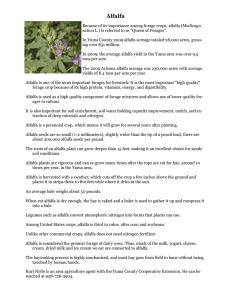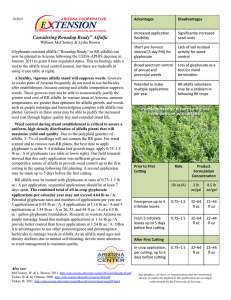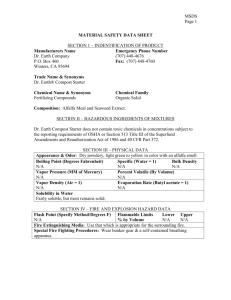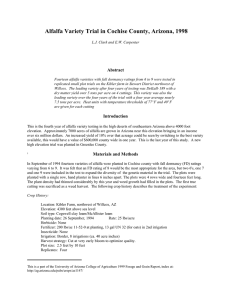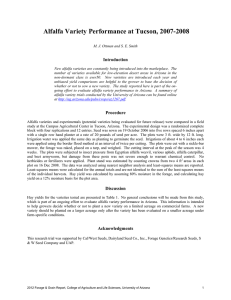Alfalfa Tolerance to Norflurazon (Zorial 5G)
advertisement
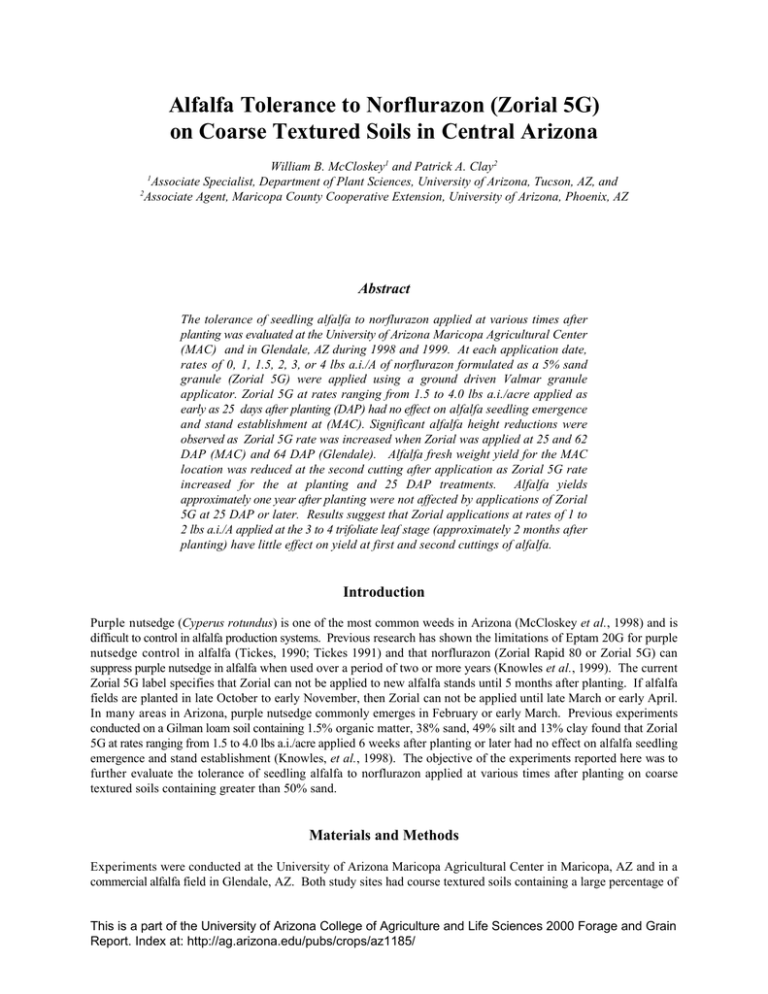
Alfalfa Tolerance to Norflurazon (Zorial 5G) on Coarse Textured Soils in Central Arizona William B. McCloskey1 and Patrick A. Clay2 Associate Specialist, Department of Plant Sciences, University of Arizona, Tucson, AZ, and 2 Associate Agent, Maricopa County Cooperative Extension, University of Arizona, Phoenix, AZ 1 Abstract The tolerance of seedling alfalfa to norflurazon applied at various times after planting was evaluated at the University of Arizona Maricopa Agricultural Center (MAC) and in Glendale, AZ during 1998 and 1999. At each application date, rates of 0, 1, 1.5, 2, 3, or 4 lbs a.i./A of norflurazon formulated as a 5% sand granule (Zorial 5G) were applied using a ground driven Valmar granule applicator. Zorial 5G at rates ranging from 1.5 to 4.0 lbs a.i./acre applied as early as 25 days after planting (DAP) had no effect on alfalfa seedling emergence and stand establishment at (MAC). Significant alfalfa height reductions were observed as Zorial 5G rate was increased when Zorial was applied at 25 and 62 DAP (MAC) and 64 DAP (Glendale). Alfalfa fresh weight yield for the MAC location was reduced at the second cutting after application as Zorial 5G rate increased for the at planting and 25 DAP treatments. Alfalfa yields approximately one year after planting were not affected by applications of Zorial 5G at 25 DAP or later. Results suggest that Zorial applications at rates of 1 to 2 lbs a.i./A applied at the 3 to 4 trifoliate leaf stage (approximately 2 months after planting) have little effect on yield at first and second cuttings of alfalfa. Introduction Purple nutsedge (Cyperus rotundus) is one of the most common weeds in Arizona (McCloskey et al., 1998) and is difficult to control in alfalfa production systems. Previous research has shown the limitations of Eptam 20G for purple nutsedge control in alfalfa (Tickes, 1990; Tickes 1991) and that norflurazon (Zorial Rapid 80 or Zorial 5G) can suppress purple nutsedge in alfalfa when used over a period of two or more years (Knowles et al., 1999). The current Zorial 5G label specifies that Zorial can not be applied to new alfalfa stands until 5 months after planting. If alfalfa fields are planted in late October to early November, then Zorial can not be applied until late March or early April. In many areas in Arizona, purple nutsedge commonly emerges in February or early March. Previous experiments conducted on a Gilman loam soil containing 1.5% organic matter, 38% sand, 49% silt and 13% clay found that Zorial 5G at rates ranging from 1.5 to 4.0 lbs a.i./acre applied 6 weeks after planting or later had no effect on alfalfa seedling emergence and stand establishment (Knowles, et al., 1998). The objective of the experiments reported here was to further evaluate the tolerance of seedling alfalfa to norflurazon applied at various times after planting on coarse textured soils containing greater than 50% sand. Materials and Methods Experiments were conducted at the University of Arizona Maricopa Agricultural Center in Maricopa, AZ and in a commercial alfalfa field in Glendale, AZ. Both study sites had course textured soils containing a large percentage of This is a part of the University of Arizona College of Agriculture and Life Sciences 2000 Forage and Grain Report. Index at: http://ag.arizona.edu/pubs/crops/az1185/ sand (Table 1.) The fields in which the experiments were conducted were nearly level basins that were flood irrigated. The fields were disced and leveled prior to planting but no herbicides were applied prior to planting. A non-dormant alfalfa variety, Germains WL525, was planted at a seeding rate of 25 lb/acre (A) into dry soil on November 23, 1998 at the Maricopa Ag. Center. Four experiments that differed only with respect to the Zorial 5G application time were established using a randomized complete block design with five replications or blocks. Individual plots were 20 ft wide by 35 ft long and Zorial 5G was applied to the entire plot. In all experiments at both locations, Zorial 5G was applied at 0, 20, 30, 40, 60 and 80 lb/A (corresponding to 0, 1, 1.5, 2, 3, and 4 lb/A of norflurazon) using a ground driven Valmar (model 1255 PT) small plot granular applicator towed by a small tractor. The first set of Zorial 5G treatments was applied on November 24, 1998, one day after planting, and the field was irrigated on November 27, 1998, four days after planting. Since the irrigation was necessary to germinate the seed and to incorporate the herbicide, November 27 is considered to be both the effective planting date and herbicide application date. The second set of Zorial 5G treatments were applied to newly planted alfalfa when the seedlings had 1 unifoliate leaf on December 22, 1998. The field was irrigated on the same day and these treatments are referred to as the 25 day after planting (DAP) treatments. The third set of Zorial 5G treatments were applied to the alfalfa when the seedlings had 3 to 4 trifoliate leaves on January 27, 1999. The field was irrigated on January 28, 1999 and these treatments are referred to as the 62 DAP treatments. The fourth set of Zorial 5G treatments were applied to the alfalfa when the plants had about 27 trifoliate leaves and were 8 inches tall on March 3, 1999. The field was irrigated on March 4, 1999 and these treatments are referred to as the 97 DAP treatments. Alfalfa stand counts were made in late January 1999 and late October/early November (see data tables for dates) in all four experiments by sub-sampling each plot two or three times using 0.25 m2 squares and counting all green seedlings or crowns in the sampling squares. Alfalfa plant height was measured by sub-sampling each plot twice and averaging the values on April 14, 1999 one day before the alfalfa was harvested for the first time to assess the degree of injury caused by the herbicide treatments. Plot yield data was not collected at the first cutting due to presence of differential amounts of weed biomass between treatments. The experiments were harvested in mid-June (see data tables for dates) at the second cutting of this alfalfa field and again in late October. Fresh weight forage yields were measured using a small plot forage harvester. Alleys between adjacent plots were cut with a commercial forage harvester to facilitate the use of the plot harvester. The harvested area in each plot was 5 ft wide (the width of the small plot cutting bar) by the length of the remaining alfalfa between alleys. Actual harvested plot lengths were measured and ranged between 18 to 21 feet. The small plot forage harvester deposited the harvested alfalfa in a weigh basket and the fresh weight of each sample was measured immediately after cutting using a digital hanging scale. The experimental field in Glendale, AZ was planted to a non-dormant alfalfa variety, Meca II, on December 20, 1998 in a manner similar to that described for the Maricopa Ag. Center study site. No herbicides were applied prior to or at planting but Pursuit 2AS at a rate of 6 oz/A was applied when the alfalfa had two trifoliate leaves on January 22, 1999. The Zorial 5G treatments were applied when the alfalfa seedlings had 3 to 4 trifoliate leaves on February 22, 1999 (64 DAP). Since the field was irrigated on February 25, 1999, this treatment was considered a 67 DAP treatment. Alfalfa populations were counted on June 3, 1999 (101 DAT) by sub-sampling each plot four times using 0.25 m2 squares and on November 1, 1999 (252 DAT) by sub-sampling each plot twice using 0.5 m2 squares and counting all green seedlings or crowns in the sampling squares. Alfalfa injury, primarily stunting with some venal chlorosis, was visually estimated on April 28, 1999 (65 DAT). Plant height was measured on the same day by sub-sampling each plot five times and averaging the values. Yield data was collected at the first cutting after planting on April 28, 1999. The fresh weight of alfalfa in each plot was measured using a small plot forage harvester and the procedure described above for the experiment at the Maricopa Ag. Center. Results and Discussion Alfalfa populations at the Maricopa Ag. Center (MAC) on January 21, 1999 (30 DAT) were reduced 48% when 20 lb/A of Zorial 5G was applied at planting and higher Zorial 5G rates further reduced populations (Table 2, Figure 1). Population assessments made on November 1, 1999 almost one year after treatment showed both the normal decline of alfalfa populations with time (285 plants m-2 down to 131 plants m-2 in the untreated plots) and declining populations as the rate of Zorial 5G was increased (Table 2, Figure 1). Similarly, Knowles et. al. (1998) found that Zorial 5G applied at planting reduced alfalfa populations averaged over all counting dates by 57 to 82% at rates ranging from 30 to 80 lb/A, respectively. In contrast to the at planting applications, regression analysis showed that Zorial 5G applied at rates up to 80 lb/A 25 DAP when alfalfa had one unifoliate leaf did not significantly reduce alfalfa populations 30 and 314 DAT at the Maricopa Agricultural Center although the data again illustrate the normal decline in the density of alfalfa crowns with time (Figure 2, Table 3). Similarly, Zorial 5G applied at rates of 20 to 80 lb/A when alfalfa had 3 to 4 trifoliate leaves (62 DAP at the Maricopa Ag.Center and 64 DAP at Glendale, AZ) had no effect on alfalfa populations counted two to nine months after treatment (Table 4, Figure 2, Table 6). As from the above data, the population of alfalfa was not reduced by Zorial 5G applications 97 DAP when the crowns had stems that were about 8 inches tall and there were about 27 trifoliate leaves per crown (Table 5). In conclusion, non-dormant alfalfa populations are very tolerant to high rates of Zorial 5G (i.e., 3 and 4 lb a.i./A of norflurazon) even when plants have a small number of leaves. However, the data (Figure 1, Table 2) clearly show that seed germination and seedling establish are negatively affected by norflurazon. Thus, Zorial 5G should not be applied before or at the time of alfalfa planting. Alfalfa height measurements made prior to the first cutting of new alfalfa fields indicated that both the time of application and the rate of Zorial 5G affected height. Alfalfa height was significantly reduced as Zorial 5G rate increased when Zorial was applied at planting, 25 DAP, and 62 DAP at MAC and 64 DAP at Glendale with the regressions accounting for 46, 59, 53 and 71% of the variation in the height data, respectively (Figure 3). The height reductions ranged from 14% at 20 lb of Zorial 5G/A applied 25 DAP at MAC up to 43% at 80 lb of Zorial 5G/A (Table 3). At Glendale, the height reductions ranged from 13 to 35% when Zorial 5G was applied 64 DAP (Table 6). In contrast, at MAC when Zorial 5G was applied 62 DAP, the height reductions were less than 5% at 20 and 30 lb/A of Zorial 5G and ranged up to 29% at 80 lb/A (Table 4). Alfalfa height was not affected by Zorial 5G applied 97 DAP when the alfalfa crowns had 27 trifoliate leaves and were 8 inches tall as indicated by a non-significant regression (Figure 3, Table 5). In general, there was a lot of variation in the height data but the degree of height reduction was slight to moderate (2 to 17%) at low rates of Zorial 5G (i.e., 20 and 30 lb/A) applied 25, 62 and 64 DAP and no visible symptoms were noted on the alfalfa plants. When the alfalfa was more mature at 97 DAP, Zorial 5G had little effect on alfalfa height at MAC, however, high rates of Zorial 5G (80 lb) have been noted to cause stunting of 2 and 3 year old alfalfa plants (W.B. McCloskey, personal observation). A Pursuit application at the second trifoliate leaf and resulting weed control allowed plot harvest at the first cutting of the Gendale, AZ experiment without the confounding influence of differential weed biomass between treatments. The linear regression of forage fresh weight against Zorial 5G rate was significant (P = 0.017) but the regression only accounted for about 20% of the variation in the data in contrast to the regression of height against Zorial 5G rate which accounted for about 71% of the variation in the height data (Figure 4). Based on data from Glendale, AZ and the decline in alfalfa height at MAC with increasing Zorial 5G rate, particularly at rates of 40 lb/A and above, the first cutting fresh weight yields at MAC were probably reduced by Zorial 5G. Actual forage yields at the first cutting were not measured due to differential weed biomass between treatments at MAC. Linear regression analysis of the alfalfa fresh weights measured at the second cutting at MAC in June 1999 showed that increasing Zorial 5G rate decreased fresh weight significantly when it was applied at planting (Adj. R2 =0.40, P < 0.001) or 25 DAP (Adj. R2 =0.261, P = 0.002) (Figure 5). Differences in fresh weights between untreated plots and plots treated with 20 or 30 lb Zorial 5G/A were small, with the yield reductions ranging between 2 and 8% (Tables 2, 3, 4 and 5). The regressions of alfalfa fresh weights against Zorial 5G rates applied 62 and 97 DAP at MAC were not significant indicating that there was little effect of Zorial 5G on yield except at the highest rates. Alfalfa forage yields were measured almost 1 year after planting to detect any long-term effects of Zorial 5G. The regression of fresh weight against Zorial 5G rate applied at planting was significant (lb/A = 8755 -[9.917 x Zorial 5G rate], Adj R2 = 0.226, P = 0.005) and was probably a consequence of the significant reduction in populations measured on November 1, 1999 (Table 2, Figure 1). However, Zorial 5G applications made at the one true leaf growth stage or later had no effect plant populations or forage yields. The height and yield data from the first and second cuttings indicate that Zorial 5G rates of 20 to 40 lb/A may slightly reduce alfalfa forage fresh weights at the first cutting particularly if Zorial is applied at planting or 1 month after planting. However, applications made at the 3 to 4 trifoliate leaf stage (approximately 2 months after planting in these experiments) and later have little if any effect on forage yields at the first and second cuttings except at the 60 and 80 lb/A Zorial rates. Except for at planting applications that reduce alfalfa populations, there were no long term effects of Zorial 5G when it was applied at the 1 true leaf stage or later. In conclusion, early spring applications of Zorial 5G at rates of 20 or 30 lb/A for purple nutsedge control can be safely made as early as 2 months after planting or at the 3 to 4 trifloliate leaf stage which ever comes later. Such applications for purple nutsedge control should be part of a planned program in which a second Zorial application is made in early summer (e.g., June) during the first year of the alfalfa stand. Previous research (Knowles et. al., 1999) has shown that Zorial applications must be made for two to three years to obtain long-term suppression on purple nutsedge in alfalfa fields. References Knowles, T.C., B. McCloskey, and J. McGuire. 1998. Effect of granular norflurazon (Zorial 5G) on alfalfa establishment in Parker Valley. Forage and Grain, Univ. of Arizona College of Agriculture Report. Series P-114. October 1998. p. 23-29. Knowles, T.C., B. McCloskey, and J. McGuire. 1999. The use norflurazon (Zorial 5G) in Parker Valley alfalfa for purple nutsedge suppression in 1998-99. Forage and Grain, Univ. of Arizona College of Agriculture Report. Series P118. December 1999. p. 53-58. McCloskey, W.B., P.B. Baker and W. Sherman. 1988. Survey of cotton weeds and weed control practices in Arizona upland cotton fields. Cotton, Univ. of Arizona College of Agriculture Report, Series P-112. p.241-254. Tickes, B.R. 1990. Nutsedge control in alfalfa. 1990 Yuma County Farm Notes. University of Arizona Cooperative Extension. Yuma, AZ. p. 7. Tickes, B.R. 1991. Eptam granules for nutsedge control in established alfalfa. Yuma County Farm Notes/September 1991. University of Arizona Cooperative Extension. Yuma, AZ. p. 12-14. Table 1. Soil texture analysis for the soils in the Maricopa and Glendale experiments. Study Site Zorial 5G Application Timing Textural Class Organic matter Sand Silt Clay (%) (%) (%) (%) (DAP) Maricopa Glendale 0 sandy loam 0.94 66 17 17 25 sandy loam 0.95 64 19 17 62 sandy loam 0.80 66 16 13 97 loam 0.87 44 41 15 67 sandy loam 0.72 57 28 15 Table 2. Effect of various rates of Zorial 5G when applied at planting (0 DAP) at the Maricopa Ag. Center on alfalfa plant populations on January 25, 1999 (59 DAT) and November 1, 1999 (339 DAT), on plant heights on April 14, 1999 (138 DAT) and on machine harvested fresh weights on June 14, 1999 (199 DAT) and October 29, 1999 (336 DAT). Alfalfa Stand Counts1 Alfalfa height Alfalfa Fresh Weight Application Rate 1-25-99 11-1-99 4-14-99 6-14-99 10-29-99 (lbs Zorial 5G/A) (plants/m2) (plants/m2) (inches) (lbs/acre) (lbs/acre) 0 285 a2 131 a 13.8 a 11788 a 8781 a 20 147 b 97 ab 10.6 b 11555 a 8837 a 30 144 b 85 b 10.4 b 10862 ab 8425 ab 40 130 bc 88 b 10.0 b 10156 ab 8148 ab 60 82 c 84 b 8.8 b 9771 ab 7682 b 80 104 bc 71 c 8.9 b 8917 b 8330 ab 2 Data are means of five plots with three (1/25/99) or two (11/1/99) 0.25 m sub-samples per plot. 2 Means within columns followed by the same letter are not significantly different at the 0.05 level of probability according to Tukey’s Honestly Significant Difference (HSD). 1 Table 3. Effect of various rates of Zorial 5G when applied 25 DAP (December 22, 1998) at the Maricopa Ag. Center on alfalfa plant populations on January 21, 1999 (30 DAT) and November 1, 1999 (314 DAT), on plant heights on April 14, 1999 (113 DAT) and on machine harvested fresh weights on June 15, 1999 (175 DAT) and October 29, 1999 (311 DAT). Alfalfa Stand Counts1 Alfalfa height Alfalfa Fresh Weight Application Rate 1-21-99 11-1-99 4-14-99 6-15-99 10-29-99 (lbs Zorial 5G/A) (plants/m2) (plants/m2) (inches) (lbs/acre) (lbs/acre) 0 353 a2 136 a 12.2 a 9931 a 8868 a 20 361 a 138 a 10.5 ab 9274 ab 8481 a 30 368 a 136 a 10.1 abc 9299 ab 8884 a 40 373 a 140 a 8.0 cd 8745 ab 9058 a 60 332 a 133 a 8.4 bcd 8605 ab 8594 a 80 404 a 131 a 7.0 d 7526 b 8550 a 2 Data are means of five plots with three (1/21/99) or two (11/1/99) 0.25 m sub-samples per plot. 2 Means within columns followed by the same letter are not significantly different at the 0.05 level of probability according to Tukey’s Honestly Significant Difference (HSD). 1 Table 4. Effect of various rates of Zorial 5G when applied 62 DAP (January 28, 1999) at the Maricopa Ag. Center on alfalfa plant populations on October 22, 1999 (268 DAT), on plant heights on April 14, 1999 (77 DAT) and on machine harvested fresh weights on June 11, 1999 (135 DAT) and October 20, 1999 (266 DAT). Alfalfa Stand Counts1 Alfalfa height 10-22-99 4-14-99 6-11-99 10-20-99 (lbs Zorial 5G/A) (plants/m2) (inches) (lbs/acre) (lbs/acre) 0 126 a2 13.8 a 15651 a 9069 a 20 133 a 13.2 a 14799 a 9313 a 30 115 a 13.4 a 15463 a 9581 a 40 127 a 12.0 ab 15049 a 9499 a 60 120 a 12.2 a 13767 a 9184 a Application Rate Alfalfa Fresh Weight 80 120 a 9.8 b 14334 a 8753 a 2 Data are means of five plots with three (1/21/99) or two (11/1/99) 0.25 m sub-samples per plot. 2 Means within columns followed by the same letter are not significantly different at the 0.05 level of probability according to Tukey’s Honestly Significant Difference (HSD). 1 Table 5. Effect of various rates of Zorial 5G when applied 97 DAP (March 4, 1999) at the Maricopa Ag. Center on alfalfa plant populations on October 22, 1999 (233 DAT), on plant heights on April 14, 1999 (42 DAT) and on machine harvested fresh weights on June 11, 1999 (99 DAT) and October 20, 1999 (231 DAT). Alfalfa Stand Counts1 Alfalfa height 10-22-99 4-14-99 6-10-99 10-20-99 (lbs Zorial 5G/A) (plants/m2) (inches) (lbs/acre) (lbs/acre) 0 137 a2 12.7 a 15508 a 9340 a 20 140 a 12.5 a 15013 a 9509 a 30 142 a 12.6 a 15256 a 9559 a 40 144 a 10.8 a 13977 a 9070 a 60 131 a 11.2 a 13174 a 9302 a Application Rate Alfalfa Fresh Weight 80 141 a 12.4 a 13471 a 9305 a 2 Data are means of five plots with three (1/21/99) or two (11/1/99) 0.25 m sub-samples per plot. 2 Means within columns followed by the same letter are not significantly different at the 0.05 level of probability according to Tukey’s Honestly Significant Difference (HSD). 1 Table 6. Effect of various rates of Zorial 5G when incorporated on February 25, 1999 (67 DAP) in Glendale, AZ on alfalfa plant populations on June 3, 1999 (98 DAT) and November 1, 1999 (249 DAT), on plant injury and plant heights on April 28, 1999 (62 DAT) and on machine harvested fresh weights on April 28, 1999 (62 DAT) and December 6, 1999 (290 DAT). Alfalfa Stand Counts1 Alfalfa Injury Alfalfa Height 11-1-99 4-28-99 4-28-99 4-28-99 12-6-99 (plants/m2) (plants/m2) (%) (inches) (lbs/acre) (lbs/acre) 0 169 a2 110 a 0d 16.6 a 8940 a 7820 a 20 155 a 113 a 10 cd 14.0 b 6782 ab 7634 a 30 166 a 110 a 10 cd 14.4 ab 7715 ab 7728 a 40 174 a 116 a 19 bc 13.6 b 7692 ab 7447 a 60 179 a 106 a 34 ab 12.1 bc 5794 b 7274 a Application Rate 6-3-99 (lbs Zorial 5G/A) Alfalfa Fresh Weight 80 150 a 106 a 43 a 10.8 c 5314 b 7673 a 2 2 Data are means of four plots with four 0.25 m sub-samples (6/3/99) or two 0.5 m sub-samples (11/1/99) per plot. 2 Means within columns followed by the same letter are not significantly different at the 0.05 level of probability according to Tukey’s Honestly Significant Difference (HSD). 1 -2 Alfalfa Population (plants m ) 400 1//25/99 1/25/99 Regr 11/1/99 11/1/99 Regr 350 300 250 200 150 100 50 0 0 20 40 60 80 100 Zorial 5G Applied at Planting (lb/A) Figure 1. Effect of Zorial 5G applied at planting on alfalfa populations at the Maricopa Agricultural Center on January 25, 1999 (59 DAT) and on November 1, 1999 (339 DAT). The linear regression equation for the alfalfa population at 59 DAT was: popln. = 227.3 - (2.01 x Zorial 5G rate), Adj. R2 = 0.56, P < 0.001. The linear regression equation for the alfalfa population at 339 DAT was: popln. = 116.6 - (0.614 x Zorial 5G rate) Adj. R2 = 0.334, P < 0.001. 600 Alfalfa Population (plants m -2) 1/21/99 500 alfalfa popn 1/21/99 Regr 11/1/99 alfalfa popln 11/1/99 Regr 400 300 200 100 0 0 20 40 60 80 100 Zorial 5G Applied 25 DAP (lb/A) Figure 2. Effect of Zorial 5G applied at planting on alfalfa populations at the Maricopa Agricultural Center on January 25, 1999 (59 DAT) and on November 1, 1999 (339 DAT). The regression of alfalfa population 59 DAT against Zorial 5G rate was not significant (Adj. R2 = 0.0, P = 0.33). Similarly, the regression of alfalfa population 339 DAT against Zorial 5G rate was not significant (Adj. R2 = 0.0, P = 0.52). 20 0 DAP MAC 25 DAP MAC 18 62 DAP MAC Alfalfa Height (inches) 97 DAP MAC 64 DAP Glendale 16 14 12 10 8 6 0 20 40 60 80 100 Zorial 5G Rate (lb/A) Figure 3. Decline of alfalfa height measured prior to first harvest with increasing rate of Zorial 5G applied at various times after planting. The linear regression equation for alfalfa height at MAC when Zorial 5G was applied at planting was: inches = 12.57 - (0.055 x Zorial 5G rate), Adj. R2 = 0.465, P < 0.001. The linear regression equation for alfalfa height at MAC when Zorial 5G was applied 25 DAP was: inches = 11.767 - (0.0613 x Zorial 5G rate), Adj. R2 = 0.595, P < 0.001. The linear regression equation for alfalfa height at MAC when Zorial 5G was applied 62 DAP was: inches = 14.177 - (0.0454 x Zorial 5G rate), Adj. R2 = 0.532, P < 0.001. The linear regression of alfalfa height at MAC when Zorial 5G was applied 97 DAP against Zorial 5G rate was not significant (Adj. R2 = 0.008, P = 0.276). The linear regression equation for alfalfa height at Glendale when Zorial 5 G was applied 64 DAP was: inches = 16.2 - (0.0667 x Zorial 5G rate), Adj. R2 = 0.711, P < 0.001. Data points are means (n = 5 at MAC; n = 4 at Glendale) ± standard errors of the mean. 20 16000 14000 16 12000 14 12 10000 10 8000 8 6000 6 4 2 4000 Height 65 DAT Height Regr Fresh Weight 65 DAT Fresh Weight Regr 2000 0 0 20 Alfalfa Yield (lb/A) Alfalfa Height (inches) 18 40 60 80 0 100 Zorial 5G Applied 64 DAP (lb/A) Figure 4. Decline of alfalfa height and alfalfa fresh weight yield in response to increasing rates Zorial 5G in Glendale at the first harvest 65 DAT. The linear regression equation for alfalfa height was: inches = 16.2 - (0.0667 x Zorial 5G rate), Adj. R2 = 0.711, P < 0.001. The linear regression equation for alfalfa fresh weight was: lb/A = 8635 - (40.78 x Zorial 5G rate) Adj. R2 = 0.198, P = 0.017. 20000 0 DAP MAC 25 DAP MAC 62 DAP MAC 97 DAP MAC 64 DAP Glendale 18000 Alfalfa Fresh Weight (lb/A) 16000 14000 12000 10000 8000 6000 4000 0 20 40 60 80 100 Zorial 5G Rate (lb/A) Figure 5. Decline of alfalfa fresh weight at the second cutting at MAC (June 1999) and the first cutting at Glendale (April 1999) with increasing rate of Zorial 5G applied at various times after planting. The linear regression equation for weight at MAC when Zorial 5G was applied at planting was: lb/A = 11946 - (36.74 x Zorial 5G rate), Adj. R2 = 0.400, P < 0.001. The linear regression equation for alfalfa weight at MAC when Zorial 5G was applied 25 DAP was: lb/A = 9957 - (27.10 x Zorial 5G rate), Adj. R2 = 0.261, P = 0.002. The linear regression of alfalfa fresh weight against Zorial 5G applied 62 DAP at MAC was not significant (Adj. R2 = 0.067, P = 0.09). The linear regression of alfalfa fresh weight against Zorial 5G applied 97 DAP at MAC was also not significant (Adj. R2 = 0.00, P = 0.593). The linear regression equation for alfalfa weight at Glendale when Zorial 5 G was applied 64 DAP was: lb/A = 8635 (40.78 x Zorial 5G rate), Adj. R2 = 0.198, P = 0.017. Data points are means (n = 5 at MAC; n = 4 at Glendale) ± standard errors of the mean.


